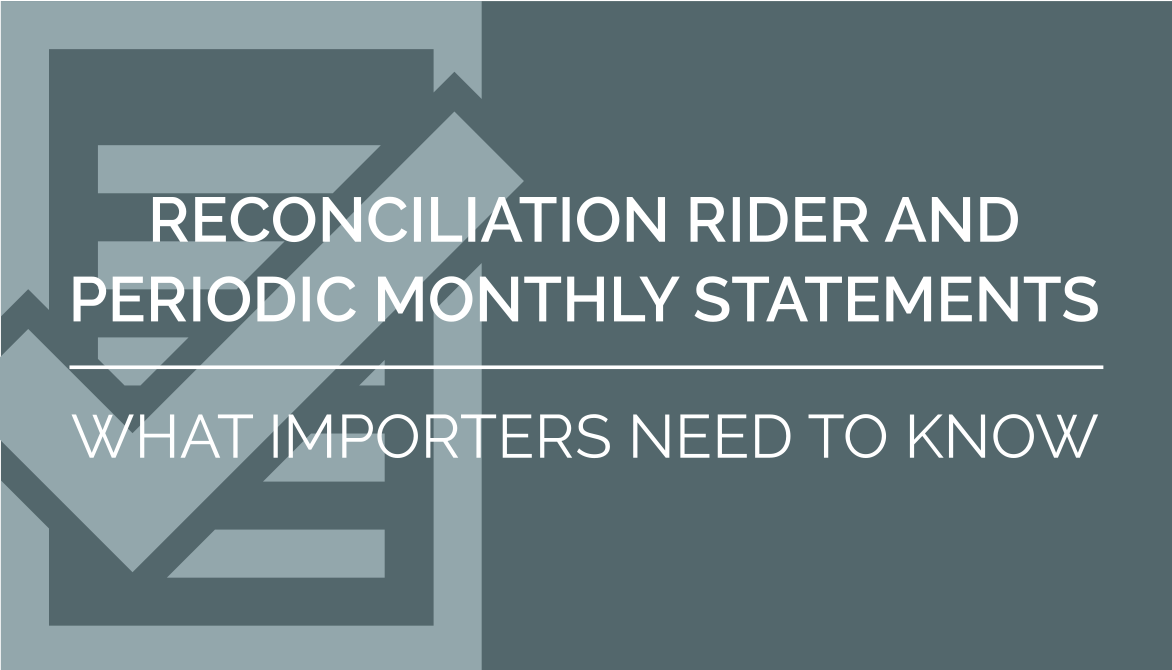The Reconciliation Rider and Periodic Monthly Statements are a couple of tools companies use to make the importing process even easier. This content will teach you more about each one’s specifics, and help you decide if you could benefit from their implementation.
Reconciliation Rider
- The basics – Also known as an Aggregate Reconciliation Rider, this addition requires an importer to use reasonable care when filing entry summaries with Customs and Border Protection (CBP), and report the actual value of imported commodities at a later date. As some importers have several shipments per day, using the Reconciliation Rider allows them the opportunity to accurately value their imports at a place and time other than the port of entry.
- How it works – The importer of record must have the Reconciliation Rider written into their policy by their surety agency, Customs Broker, or Freight Forwarder when purchasing an importer bond. Often times the supplier of the bond will require additional fees and full FS underwriting for this rider. When shipments start coming in, the importer uses their best judgment to value the commodities at the port of entry and report them to CBP. At a later date, the importer must provide a full and accurate report to CBP, detailing the market value of the imported commodities. This is usually based on the current market value of the goods with regard to applicable free trade agreements. Then, depending on the updated value of the goods either a refund or a bill will be supplied by CBP.
- Entries can be summarized in two ways – Individual Entry Flagging or via Blanket Flagging. This means an importer can either chose to have individual shipments flagged for reconciliation or opt to have shipments for a specified period of time be reconciled.
- The specifics – Importers have 15 to 21 months to address the actual value of commodities they intent to reconcile. This is only valid for continuous importer bonds, as all single entry bonds are ineligible for this service.
Periodic Monthly Statements
- The basics – Periodic Monthly Statements occur when an importer opts to pay duties/fees once a month versus on each individual entry. Usually utilized by an importer with a large number of imports, this policy addition makes monthly payments more efficient than paying on every individual entry.
- How it works – Customs offers this service on their website, and once the importer is signed up they are allowed to make monthly payments on their entries. Importers can apply for Periodic Monthly Statements without the aid of a Surety Agency, Customs Broker, or Freight Forwarder.
- The specifics – Using Periodic Monthly Statements allows importers to make consolidated payments on entries as late as the 15th business day of the following month in which the goods were imported. Via Customs interface, importers can view statements as they are being compiled and plan accordingly.
As you can see, the Reconciliation Rider and Periodic Monthly Statements make importing practices more consolidated and efficient. Now that you know what these policy additions are about, consider evaluating your business’s importing practices and decide if they could help you too.







![[Webinar] How Could Changes to De Minimis Impact Your Company?](https://traderiskguaranty.com/trgpeak/wp-content/uploads/2025/05/trg-how-de-minimis-impacts-customs-bond-webinar-400x250.png)